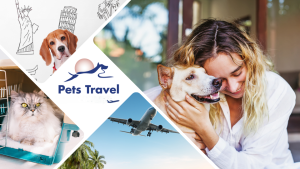Pet and animal
How to Travel with Your Pet Stress Free

Introduction
Traveling with a pet can be a fun and rewarding experience. When you plan well, you can enjoy adventures with your furry friend without worry or stress. Many people love to explore new places with their pets, but the idea of traveling can sometimes feel overwhelming. The key is to prepare and follow some simple steps so that both you and your pet have a great time. In this article, we will explore practical tips to help you travel with your pet stress-free. We will cover how to plan your trip, what to pack, and how to keep your pet safe and happy on the road. This guide is easy to read and understand, perfect for anyone who wants to make pet travel enjoyable.
Understanding Pet Travel

Image by: Yandex.com
Traveling with your pet means planning trips where your pet can come along safely and happily. It is not only about booking pet-friendly hotels or finding parks to play in; it is also about creating a travel plan that considers your pet’s needs. A successful pet trip includes ensuring your pet is healthy, comfortable, and well-prepared for the journey. When you focus on pet travel planning, you can avoid many common problems and have a smooth adventure.
Pet travel can include many forms of transportation. Whether you are traveling by car, train, or airplane, it is important to know the rules and tips that will help your pet adjust to new surroundings. Understanding these basics will help you feel more confident when planning your trip and make the experience enjoyable for your pet and you.
Key Planning Steps for Pet Travel

Image by: Yandex.com
1. Plan Your Itinerary in Advance
Start by deciding on your destination and researching pet-friendly accommodations, restaurants, and attractions. Planning ahead means you can find places that welcome pets and have the right facilities. Create a travel itinerary that includes breaks for your pet to stretch and use the bathroom. When you plan your route, choose stops with open spaces or parks so your pet can relax and play.
2. Visit the Vet Before Your Trip
Before you travel, take your pet to the veterinarian for a check-up. Make sure your pet’s vaccinations are up-to-date and ask for any travel advice specific to your pet. A visit to the vet can also include obtaining a health certificate if you plan to travel by air. This step is essential to ensure your pet is healthy and ready for the journey.
3. Pack Essential Items for Your Pet
Packing the right items for your pet is important. Make a list of everything your pet might need during the trip. Items should include food, water, a bowl, any medications, and a favorite toy or blanket for comfort. Do not forget waste bags, grooming supplies, and a leash or carrier. Packing smart ensures that your pet has everything needed to feel secure and happy on the road.
4. Research Pet Travel Regulations
Different transportation methods have different rules for pet travel. Check the regulations for airlines, trains, or rental cars regarding pet travel. Make sure you understand the requirements for carriers, vaccinations, and any fees that might apply. Being informed will help you avoid surprises and ensure a smooth journey.
5. Consider Your Pet’s Comfort and Safety
When planning your travel, consider your pet’s comfort and safety at every step. Choose a comfortable carrier or travel bed for your pet and ensure that your vehicle is safe and well-ventilated. Keep your pet’s favorite items nearby to reduce anxiety. Knowing that your pet is safe and comfortable makes the entire trip more enjoyable.
Practical Tips for Stress-Free Pet Travel

Image by: Yandex.com
1. Start with Short Trips
If your pet is not used to traveling, begin with short trips. Take your pet on a weekend getaway to see how they adjust to the change. Gradually increase the duration of your trips as your pet becomes more comfortable with traveling. Short trips can build your pet’s confidence and help you learn what works best.
2. Establish a Routine
Creating a routine for travel can help reduce stress. Feed your pet at the same time each day, take regular breaks, and maintain familiar activities. This routine helps your pet know what to expect and makes the journey feel more secure. Consistent habits make both you and your pet feel calm during travel.
3. Keep Your Pet Hydrated and Fed
It is easy to forget to offer your pet enough water and food during a long trip. Always carry extra water and food, and plan stops where your pet can eat and drink comfortably. Keeping your pet hydrated and fed is crucial for their well-being and helps prevent any travel-related stress.
4. Use Calming Aids
Some pets may feel anxious during travel. Consider using calming aids like a pet pheromone spray, calming treats, or a favorite toy to help soothe your pet. These simple aids can make a big difference in keeping your pet relaxed during the journey.
5. Plan for Entertainment
Traveling can be boring for pets if they are left alone for long periods. Bring along interactive toys or chew items to keep your pet entertained. These small distractions help reduce boredom and make the trip more pleasant for your pet.
The Long-Term Benefits of Traveling with Your Pet

Image by: Yandex.com
Traveling with your pet can bring many long-term benefits. Spending time together on trips strengthens your bond and creates lasting memories. These shared experiences can improve your pet’s social skills and boost their confidence in new environments. For you, traveling with your pet can reduce stress and provide a sense of adventure.
Over time, regular travel can also lead to a healthier lifestyle for both you and your pet. The exercise from walking and exploring new places, combined with the joy of being outdoors, contributes to overall well-being. Moreover, traveling with your pet opens up opportunities to meet other pet lovers and build a supportive community.
Overcoming Common Challenges in Pet Travel
Traveling with a pet is not always easy. Some common challenges include dealing with travel anxiety, managing unexpected delays, and ensuring your pet stays comfortable. One challenge is that pets can become anxious in unfamiliar environments. To help with this, introduce your pet to travel gradually and use calming aids when needed.
Another challenge is keeping your pet safe during long journeys. Make sure your pet is secure in a comfortable carrier or harness, and always follow safety guidelines for your mode of travel. If you are traveling by car, never leave your pet alone in a hot vehicle, and plan regular stops for breaks.
Managing your time and budget can also be difficult when traveling with your pet. Research pet-friendly options in advance, and plan your itinerary with enough breaks for rest and play. Being prepared and flexible helps overcome these challenges, making the trip smoother and more enjoyable for everyone.
The Long-Term Impact of Traveling with Your Pet

Image by: Yandex.com
Traveling with your pet can change your life in many positive ways. It strengthens your bond, reduces stress, and builds lifelong memories. A well-planned trip helps both you and your pet enjoy new experiences, learn about different cultures, and lead a healthier lifestyle. Over time, these journeys contribute to personal growth and a greater sense of happiness. The joy of shared adventures and the freedom to explore new places together can inspire you to travel more often, making pet travel a rewarding habit that lasts a lifetime.
Comparative Table: Key Strategies for Stress-Free Pet Travel
| Strategy | Description | Key Benefit |
|---|---|---|
| Plan Your Itinerary | Research pet-friendly destinations and plan stops | Ensures a smooth, enjoyable journey |
| Vet Check and Documentation | Visit the vet and obtain necessary records for travel | Keeps your pet healthy and meets travel regulations |
| Pack Essentials | Make a list of food, water, medications, and toys | Prevents forgetting important items, keeps pet comfortable |
| Use Technology | Use apps to find pet-friendly hotels, reviews, and maps | Saves time, provides reliable information |
| Create a Routine | Stick to feeding, walking, and resting schedules during travel | Reduces pet anxiety, builds consistency |
| Choose Safe Transport | Use secure carriers, harnesses, and plan frequent breaks | Enhances safety and comfort during travel |
This table highlights key strategies for stress-free pet travel, detailing what each strategy involves and the benefits they offer.
Conclusion
In summary, traveling with your pet stress-free is possible with careful planning and the right strategies. By researching pet-friendly destinations, packing essential items, and maintaining a consistent routine, you can ensure a smooth and enjoyable journey. Embrace technology and prepare for unexpected challenges to keep your trip safe and fun. The long-term benefits of traveling with your pet include stronger bonds, reduced stress, and lasting memories that enrich your life.
Pet and animal
Dog Welfare: Promoting Health, Happiness, and Humane Care for Dogs

Introduction
Dogs have been our loyal companions for thousands of years, offering friendship, love, and protection. Yet, millions of dogs worldwide face neglect, abandonment, and abuse every day. Ensuring dog welfare is crucial not only for the well-being of dogs themselves but also for the health and safety of the communities they live in. This blog explores the importance of dog welfare, key practices, and how organizations and individuals can make a difference.
What Is Dog Welfare?
Dog welfare refers to the physical, emotional, and social well-being of dogs. It encompasses providing adequate food, clean water, shelter, medical care, protection from cruelty, and social interactions. A dog’s welfare is not just about survival—it’s about ensuring a life of dignity, safety, and happiness.
Good dog welfare practices also include proper training, mental stimulation, and ensuring dogs are free from unnecessary stress or harm. Communities and pet owners play a vital role in achieving this.
Why Dog Welfare Matters
Ensuring dog welfare is critical for several reasons:
- Health and Longevity: Dogs with proper care live longer, healthier lives. Access to vaccinations, regular veterinary check-ups, and a balanced diet reduces the risk of diseases and infections.
- Safety: Neglected or stray dogs can develop behavioral problems due to fear, anxiety, or hunger. By focusing on dog welfare, communities reduce the risk of bites, attacks, and the spread of disease.
- Companionship and Emotional Bonding: Dogs are social animals who thrive on attention and care. Good welfare ensures they can form positive relationships with humans and other animals.
- Ethical Responsibility: As caregivers, humans have a moral obligation to protect animals from suffering. Supporting dog welfare aligns with humane and compassionate values.
Key Components of Dog Welfare

Image by: Yandex.com
1. Adequate Shelter and Comfort
A safe, clean, and comfortable environment is the foundation of dog welfare. Dogs need protection from extreme weather, adequate space to move freely, and a secure area where they feel safe. Whether in homes, shelters, or community care facilities, proper housing significantly reduces stress and illness.
2. Nutrition and Clean Water
Proper nutrition is essential for maintaining a dog’s health. A balanced diet that includes proteins, vitamins, and minerals supports growth, energy, and immunity. Alongside food, constant access to clean drinking water is crucial. Malnutrition and dehydration are major causes of illness in neglected dogs.
3. Medical Care and Vaccination
Regular veterinary check-ups, vaccinations, and timely treatment for injuries or illnesses are integral to dog welfare. Preventive care such as deworming, flea control, and neutering/spaying programs not only improves individual health but also helps manage the stray dog population ethically.
4. Mental and Physical Stimulation
Dogs require exercise, play, and social interaction to maintain mental and physical health. Boredom and isolation can lead to destructive behavior, anxiety, or depression. Activities like walking, games, training, and socializing with other dogs promote well-being and happiness.
5. Protection from Cruelty and Neglect
One of the most critical aspects of dog welfare is protecting dogs from abuse. Stray, abandoned, or working dogs may face cruelty, overwork, or neglect. Enforcement of animal welfare laws, public awareness campaigns, and reporting cases of abuse are essential steps in safeguarding dog welfare.
The Role of Dog Welfare Organizations
Non-profit organizations, rescue groups, and dog welfare societies play a crucial role in improving the lives of dogs:
- Rescue Operations: Saving abandoned, injured, or abused dogs from streets, unsafe homes, or neglectful situations.
- Medical Treatment: Providing veterinary care, vaccinations, surgeries, and rehabilitation for rescued dogs.
- Adoption Programs: Rehoming rescued dogs into loving families, reducing stray populations, and promoting responsible pet ownership.
- Awareness Campaigns: Educating the community about ethical treatment, sterilization, feeding programs, and reporting cruelty.
- Community Support: Establishing feeding stations, shelters, and volunteer programs to ensure ongoing dog welfare in urban and rural areas.
Organizations like Kannan Animal Welfare Foundation and similar dog NGOs lead by example, showing how structured, compassionate efforts can transform the lives of countless dogs.
How Individuals Can Promote Dog Welfare
1. Adopt, Don’t Shop
Choosing to adopt rescued dogs supports the principles of dog welfare. Adoption reduces the demand for puppy mills and helps provide abandoned dogs with loving homes.
2. Volunteer and Support Shelters
Volunteering time at local dog shelters or rescue organizations can make a huge difference. Activities include feeding, grooming, walking, cleaning, or assisting in rescue operations. Donations of food, medicine, or funds are also vital.
3. Spay and Neuter Pets
Responsible pet owners should sterilize their dogs to prevent overpopulation. This reduces the number of stray dogs and decreases suffering caused by hunger, disease, and neglect.
4. Report Cruelty
Communities play an essential role in enforcing dog welfare. Reporting cases of abuse or neglect to local authorities or animal welfare organizations ensures that dogs in distress receive timely help.
5. Raise Awareness
Educating friends, family, and neighbors about the importance of dog welfare, ethical treatment, and responsible ownership spreads a culture of compassion and care.
Conclusion
Dog welfare is not just about providing food and shelter—it’s about creating an environment where dogs are safe, healthy, and happy. Every small effort, from adopting a rescued dog to volunteering at a shelter, contributes to a larger movement that protects vulnerable animals.
By supporting dog welfare initiatives, whether through NGOs, community programs, or personal responsibility, we ensure that dogs receive the love, care, and respect they deserve. When dogs thrive, communities thrive—because compassion towards animals reflects the humanity of society itself.
Business
Custom Dog Collar Guide: Style, Safety and Business Trends

Introduction
The pet care industry has grown rapidly over the past decade, becoming a multi-billion-dollar lifestyle market. A perfect example of this change is the custom dog collar. What used to be a simple tool for identification and leash attachment is now a statement piece. Today’s collars reflect a dog’s personality, the owner’s values, and also provide important safety features.
The Evolution of Dog Collars in Modern Pet Care
Dog collars have evolved from basic leather straps to personalized fashion accessories, reflecting how people now see their pets as family. This change has created many opportunities for businesses to innovate in the custom dog collar market.
Traditional collars were mainly for control. Today’s custom collars must do more: be durable, comfortable, safe with features like breakaway or reflective elements, and stylish to match the dog and owner. Meeting all these needs has created a whole industry focused on balancing function and fashion.
The Functional Foundation: Safety First
Before looking good, a custom dog collar must keep the dog safe and comfortable. This drives the use of better materials and ergonomic designs. Collars are made from leather, nylon, biothane, and recycled eco-friendly materials. Leather is durable and ages well, nylon is lightweight and easy to clean, and biothane is waterproof and long-lasting.
Functional features include quick-release buckles, reflective stitching for night safety, and padded interiors for sensitive dogs. Some collars even have GPS trackers, LED lights, or health sensors, adding high-tech safety and convenience.
Proper sizing and adjustability are also important. A good fit prevents escapes and avoids discomfort or injury. Custom collar makers provide guides and multiple adjustment points for growing puppies or uniquely shaped dogs. This focus on function separates quality collars from mass-produced ones.
Fashion Meets Personalization
While function is important, fashion drives much of the custom dog collar market’s growth. Many pet owners see collars as a way to show their dog’s personality and their own style. This gives designers and makers lots of creative freedom.
Personalization goes far beyond adding a dog’s name. Today’s collars include hand-tooled leather, fabric prints, gemstones, studs, beadwork, and sophisticated color combinations. Some even match the owner’s style.
Social media has made fashion even more important. Instagram and TikTok pets show off stylish collars, inspiring owners to buy statement pieces. Collars have become a way to make a social statement and start conversations.
Seasonal and themed collars are also popular. Halloween, holiday, patriotic, sports, and pop culture designs let owners celebrate events with their pets. Limited edition releases encourage repeat purchases and build collector interest.
The Business Model: From Craft to Commerce
The custom dog collar market has many business types, from solo artisans on Etsy to large pet retailers. This variety gives entrepreneurs many ways to enter the market and offers different options for customers.
- Small makers: Focus on craftsmanship with hand-sewn or leather collars. These are one-of-a-kind, often priced higher, and valued for their quality and personal story.
- Mid-sized businesses: Offer semi-custom collars where customers pick colors, patterns, hardware, and personalization. This balances customization with faster production, often using digital tools to preview designs.
- Large retailers: Partner with manufacturers for high-volume personalization using laser engraving, digital printing, or embroidery. These collars are less artisanal but more affordable and widely available.
This range of business models lets consumers choose collars based on style, price, and level of customization.
Material Innovation and Sustainability
Environmental awareness is becoming important in the custom dog collar industry. Many customers want products that match their values, so manufacturers are using sustainable materials like recycled plastic, organic cotton, vegetable-tanned leather, and hemp.
Some companies use creative eco-friendly materials like recycled ocean plastic, old climbing ropes, or plant-based leathers made from cork or mushrooms. These collars appeal to consumers who want stylish, durable products that are better for the environment.
Sustainability also includes how collars are made. Many makers focus on local production to reduce shipping emissions, use zero-waste cutting methods, or donate scraps to animal shelters. These practices tell a strong brand story and attract environmentally conscious buyers.
Technology Integration: The Smart Collar Revolution
Custom dog collars are becoming more high-tech. Smart collars can track activity, monitor health, or show GPS location, and they’re no longer just niche products. Customization keeps these collars stylish, with options like interchangeable bands and personalized designs so the tech doesn’t look boring or clinical.
Some collar makers work with tech companies to fit tracking devices into their designs. Others build the technology directly into the collar. These collars combine fashion and function, giving pet owners products that look great while keeping their pets safe and healthy.
Marketing Custom Dog Collars: Building a Brand
Marketing custom dog collars works best when you understand the bond between pets and their owners. Successful brands show that collars aren’t just products—they celebrate the special relationship between a person and their dog. Sharing photos of happy dogs wearing collars, especially from customers, builds trust and community.
Social media, especially Instagram and Pinterest, is key for marketing. Hashtags, influencers, and engaging with pet communities increase visibility and sales. Many brands encourage customers to share stories and photos, turning buyers into brand ambassadors.
The custom dog collar market is growing as more people treat pets like family. Customers want collars that are reliable, expressive, and emotionally meaningful. By combining good design with creative customization, this market has become a strong niche in the pet industry.
The future of custom dog collars is bright. New materials, designs, and even technology will keep the product exciting. Success comes from making collars that are safe and comfortable for dogs, while also stylish and appealing to owners.
Check the Other Blogs
Pet and animal
Top 10 Mistakes Puppy Owners Make and How to Avoid Them

Introduction
Many people dream of getting a dog. Puppies are so sweet and playful, bringing a lot of joy, and when they grow up, they become the most loyal of friends. But these dreams don’t always come true, and instead of bringing joy, the arrival of a small pet brings only a ton of stress, worries, and disappointments. Today, we’ll discuss how to maintain a puppy’s health and well-being, instill the foundations of good behavior, and make life together comfortable and joyful for owner and pet. To achieve this ideal, simply avoid the 10 most common mistakes.
Top 10 Mistakes Puppy Owners Make and How to Avoid Them

Image by: Yandex.com
1. Early weaning
Let’s start with a very big mistake made by inexperienced breeders and impatient buyers. Under no circumstances should puppies be separated from their mothers until they are at least 45 days old. The optimal age for acquiring a pet is considered to be 3 months, with the minimum being 2 months. Rushing to wean them is absolutely unacceptable. This can lead to serious health and psychological problems for the puppy. In the first months of life, a puppy receives the most important foundation for immunity and health from its mother’s milk, and also undergoes socialization within a pack of its fellow puppies, learning proper behavior. Furthermore, before reaching three months of age, a puppy should receive all necessary vaccinations.
2. Quick transition to another food
Another important building block in the foundation of a dog’s health: Never start feeding a puppy a different food immediately after acquiring it. The transition to an unfamiliar food should be gradual, with constant monitoring of its reaction. Moving to a new home already puts a small pet under immense stress, and a sudden change in its usual diet can lead to serious digestive upsets, leading to chronic gastrointestinal diseases.
3. Ignoring bad behavior
For some reason, many people believe that damaging things and furniture, constantly whining or barking, biting and growling, and going to the bathroom in the house are completely normal behavior for a young puppy. In fact, this is not true, and any manifestation of bad, inappropriate behavior should be immediately corrected. Pets still don’t understand much, so they need to be taught how to behave. Note: don’t scold them for their misbehavior, but explain what they did wrong.
4. Scold and punish when there is a lack of understanding
The key word here is “lack of understanding.” A puppy’s misbehavior isn’t due to an overwhelming desire to cause mischief or get its owner into trouble. The pet simply doesn’t yet understand how to behave and what is absolutely forbidden. Therefore, at an early age, a dog shouldn’t be scolded or punished; it should be explained what it did wrong. There are many training and development methods for this. It’s a different matter if a puppy repeatedly makes the same mistake, even if the training is carried out correctly.
In this case, if a pet is caught doing something unacceptable, a humane punishment may be applied :
- stern intonation in the voice,
- a light tug on the leash,
- short-term ignoring.
Once the dog has learned the lesson, it is essential to reinforce the result with a reward: affection or a treat.
The fourth mistake has another meaning: often, inexperienced puppy owners become impatient during training or education and demand too much of their pet. Remember that your pet is still too young to quickly absorb a lot of new information. Don’t scold or punish your dog if it takes a long time to understand what you want. In this case, it’s better to focus on yourself: are you doing everything correctly and is the training method you’re using suitable for your dog?
5. Start training a puppy only after problems arise
The easiest way to solve any problem is to simply prevent it from arising. Therefore, training a small pet should begin from the moment it arrives in your home. You must teach the dog to follow your rules, not wait for it to figure them out on its own through trial and error. Even if no behavioral issues are observed, they will eventually surface, and by then, they will be very difficult to correct.
6. Wrong toys
Under no circumstances should you allow your puppy to play with shoes, clothes, children’s soft toys, pillows, or any other items that don’t belong exclusively to the pet. Playing with human objects will become a major problem: the dog simply won’t understand that it shouldn’t damage its owner’s things, as it will view them as toys.
Your little pet should have exclusively their own toys, which they can use as they please. Furthermore, these personal items will become treasured by the puppy and can be used as rewards during training—the owner can play with them for good behavior and following commands. Furthermore, playing with human objects can be dangerous for a dog’s health, so it’s important to purchase special, safe toys for your pet.
7. Wrong games
This is perhaps one of the most common mistakes, causing numerous behavioral, psychological, and health problems in pets. Never allow a puppy to bite its owner or display aggressive behavior during play. This can lead to serious aggression in the future.
In addition, the owner himself should not provoke the dog to unacceptable behavior :
- tease a puppy,
- capture it,
- try to play fighting or tag with him,
- take away toys by force
- tease your pet with them,
- hit him with toys even pretending.
It’s also forbidden to train your dog to be aggressive toward other dogs, people, or even objects during play. This will lead to future aggressive behavior, and a “vicious dog” is primarily dangerous for the owner and their family.
Before 9 months of age, puppies are actively shedding their teeth, so it’s best not to overdo it during this period. Dogs love this type of play, so don’t avoid it entirely: it’s fine, but only play gently and for short periods. Overly aggressive and forceful tug-of-war can damage the dog’s bite and disrupt the growth of permanent teeth. Young puppies often have their baby teeth extracted prematurely during tug-of-war, which is very traumatic and painful, and the pet may be unable to enjoy playing with its owner for a long time after such a negative experience.
8. Isolation from other dogs and people
Many puppy owners fear that other dogs or people might harm their pet. Sometimes owners are unsure of their own puppy if it’s prone to aggression. Avoid depriving your pet of interaction with other dogs and other people. This socialization process is essential, as it’s at a young age that they learn to observe all the rules and regulations for interacting with unfamiliar creatures.
Of course, for your pet’s safety, you need to keep the situation under control: allow it to interact only with non-aggressive dogs on a leash that the owner fully controls. When interacting with strangers, do not allow them to interact too closely with your puppy, and monitor your pet’s reactions to avoid unpleasant situations.
9. Overactivity
Puppy owners often try to organize numerous, very active walks and excessive playtime for their pets in order to exhaust them. This is an attempt to deprive the dog of the energy to cause trouble: a tired pet is unlikely to chew on furniture or anything of the sort. In fact, this approach can help to some extent, but only briefly. However, the animal will feel constantly exhausted and soon be unable to rest properly, which will lead to nervous tension and unacceptable behavior.
Moreover, excessive stress on immature joints from constant, active walks can lead to musculoskeletal problems. Yes, puppies absolutely need frequent walks and interaction with their owner to satisfy their need to explore the world. But don’t tire them out every day. Exercise and rest periods should be in moderation. Furthermore, a pet also needs mental stimulation, which is even more effective at calming a restless puppy than constant, active walks.
10. Lack of attention
Another very common mistake to avoid is giving your pet too little attention. When getting a dog, be prepared to spend time on it, and if you have very little time, consider whether getting a puppy is worth it at all. A small pet will need affection and care; it will need to be trained and raised, walked, and played with. Remember that a lack of attention not only leads to chewed furniture and torn wallpaper, but also undermines your bond with your dog, which will ultimately lead to behavioral problems and dissatisfaction on the part of the owner, making life with your pet seem like a joyless chore. If you’ve ever experienced these challenges or found clever ways to overcome them you could even write for us pets and share your insights with other caring owners.
Conclusion
Raising a puppy is an exciting adventure, but it requires commitment, patience, and knowledge. By avoiding these common mistakes, you’ll be on the right path to raising a healthy, happy, and well-behaved dog. Remember, puppies need time, proper care, and training to thrive. Stay consistent, set clear boundaries, and provide plenty of socialization, exercise, and love, and your puppy will grow into a wonderful companion for years to come.
By avoiding these mistakes and being proactive in your puppy’s development, you’ll ensure that both you and your furry friend enjoy a long, happy, and healthy relationship.
-
Business2 years ago
Cybersecurity Consulting Company SequelNet Provides Critical IT Support Services to Medical Billing Firm, Medical Optimum
-
Business2 years ago
Team Communication Software Transforms Operations at Finance Innovate
-
Business2 years ago
Project Management Tool Transforms Long Island Business
-
Business2 years ago
How Alleviate Poverty Utilized IPPBX’s All-in-One Solution to Transform Lives in New York City
-
health2 years ago
Breast Cancer: The Imperative Role of Mammograms in Screening and Early Detection
-
Sports2 years ago
Unstoppable Collaboration: D.C.’s Citi Open and Silicon Valley Classic Unite to Propel Women’s Tennis to New Heights
-
Art /Entertainment3 years ago
Embracing Renewal: Sizdabedar Celebrations Unite Iranians in New York’s Eisenhower Park
-
Finance3 years ago
The Benefits of Starting a Side Hustle for Financial Freedom































